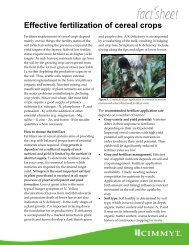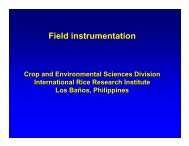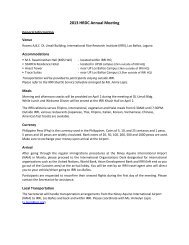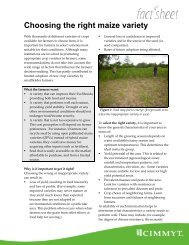Practical implementationTemperate environment/Ch<strong>in</strong>a. Promis<strong>in</strong>g aerobic <strong>rice</strong> varieties <strong>in</strong> northern Ch<strong>in</strong>a are HD277, HD297, and HD502. Beforesow<strong>in</strong>g, the land should be dry prepared by plow<strong>in</strong>g and harrow<strong>in</strong>g to obta<strong>in</strong> a smooth seedbed. Seeds should be dryseeded at 1−2-cm depth <strong>in</strong> heavy (clayey) soils and at 2−3-cm depth <strong>in</strong> light-textured (loamy) soils. Optimum seed<strong>in</strong>g ratesstill need to be established but are probably <strong>in</strong> the 60−80 kg ha −1 range. In experiments so far, row spac<strong>in</strong>gs between25 and 35 cm gave similar yields. Sow<strong>in</strong>g of the seeds can be done manually (e.g., dibbl<strong>in</strong>g the seeds <strong>in</strong> slits opened bya stick or a tooth harrow) or us<strong>in</strong>g direct-seed<strong>in</strong>g mach<strong>in</strong>ery. The total amount of fertilizer N application could probablyfollow local recommendations for lowland <strong>rice</strong> aim<strong>in</strong>g at a 4−6 t ha −1 yield level. The total amount of N to be applieddepends on <strong>in</strong>digenous soil N supply and other sources of N (such as atmospheric deposition). If no knowledge on localrecommendations is available, an amount of 90 kg N ha −1 could be a useful start<strong>in</strong>g po<strong>in</strong>t (to be subsequently optimized).Instead of basal application of the first N split, the first application can best be applied 10−12 days after emergenceto m<strong>in</strong>imize N losses by leach<strong>in</strong>g (the emerg<strong>in</strong>g seedl<strong>in</strong>gs can’t take up N fast, so it will easily leach out). Second andthird split applications can be given around maximum tiller<strong>in</strong>g and panicle <strong>in</strong>itiation, respectively. With future research,pr<strong>in</strong>ciples of site-specific nutrient <strong>management</strong> (SSNM) for aerobic <strong>rice</strong> should be developed. If the crop is grown <strong>in</strong> adry season, a light irrigation application (say 30 mm) should be given after sow<strong>in</strong>g to promote emergence. Subsequentirrigation applications should aim to frequently restore the soil water content to field capacity, and depend on the ra<strong>in</strong>fallpattern, the depth of groundwater, and on availability and/or cost of irrigation water. Irrigation can be applied by the samemeans as used for upland crops: flash flood, furrow, or spr<strong>in</strong>kler.Tropical aerobic <strong>rice</strong> systems for water-short <strong>irrigated</strong> environments are still <strong>in</strong> the research and development phase.More research is especially needed to develop high-yield<strong>in</strong>g aerobic <strong>rice</strong> varieties and susta<strong>in</strong>able <strong>management</strong> systems.In the tropical Philipp<strong>in</strong>es, the most promis<strong>in</strong>g variety so far is Apo, but the breed<strong>in</strong>g of improved varieties is <strong>in</strong> full sw<strong>in</strong>g.In general, the same <strong>management</strong> practices as for northern Ch<strong>in</strong>a can be followed. However, susta<strong>in</strong>ability seems so farmore of a problem <strong>in</strong> tropical areas than <strong>in</strong> temperate areas such as northern Ch<strong>in</strong>a. Aerobic <strong>rice</strong> should not be grownconsecutively on the same piece of land, and—depend<strong>in</strong>g on the cropp<strong>in</strong>g history and soil type—even complete yieldfailures can occur on fields cropped to aerobic <strong>rice</strong> the very first time <strong>in</strong> their history! The ma<strong>in</strong> problems to overcome <strong>in</strong>the development of tropical aerobic <strong>rice</strong> are listed <strong>in</strong> Chapter 3.6.3.4.1 Raised bedsOne of the recently proposed <strong>in</strong>novations to dealwith water scarcity <strong>in</strong> the <strong>rice</strong>-wheat system <strong>in</strong>the Indo-Gangetic Pla<strong>in</strong> is the use of raised beds,<strong>in</strong>spired by the success of the system <strong>in</strong> high-yield<strong>in</strong>g,<strong>irrigated</strong> wheat-maize areas <strong>in</strong> Mexico (Sayreand Hobbs 2004). In the system of raised beds,<strong>rice</strong> is grown on beds that are separated by furrowsthrough which irrigation water is coursed. In irrigationeng<strong>in</strong>eer<strong>in</strong>g terms, the system of raised beds iscomparable with “furrow irrigation.” Irrigation is<strong>in</strong>termittent and the soil of the beds is dom<strong>in</strong>antly<strong>in</strong> aerobic conditions; hence, the system can beconsidered an aerobic <strong>rice</strong> system (this is differentfrom the use of beds <strong>in</strong> heavy soils to ma<strong>in</strong>ta<strong>in</strong>saturated soil conditions, Chapter 3.3.1). In general,furrow irrigation is more water efficient than flashflood<strong>in</strong>g(depend<strong>in</strong>g on soil type, field dimensions,and slope of the land), and furrow irrigation shouldhold promise for aerobic <strong>rice</strong>. Though dimensionsmay vary, beds are usually around 35 cm wide,separated by furrows that are 30 cm wide and 25 cmdeep. <strong>Rice</strong> can be transplanted or direct-seeded onthe beds. So far, the raised-bed system has mostlybeen tested with current lowland <strong>rice</strong> varieties, andyield ga<strong>in</strong>s can be expected when suitable aerobicvarieties are developed/used. Tractor-pulled equipmenthas been developed that shapes the beds anddrills seed (sometimes together with fertilizers) <strong>in</strong>one operation.Among the suggested benefits of raised bedsare improved water-use and nutrient-use efficiency,improved water <strong>management</strong>, higher yields,and—when the operations are mechanized—reducedlabor requirements and improved seed<strong>in</strong>gand weed<strong>in</strong>g practices (Connor et al 2003, Hobbsand Gupta 2003). Balasubramanian et al (2003) andHobbs and Gupta (2003) reported <strong>in</strong>itial results ofon-station trials and farmer participatory evaluationof <strong>rice</strong> on beds <strong>in</strong> the <strong>rice</strong>-wheat belt <strong>in</strong> India. Yieldof <strong>rice</strong> transplanted or direct-seeded on beds wasplus/m<strong>in</strong>us 5−6% of that of puddled transplanted<strong>rice</strong>, while irrigation water sav<strong>in</strong>gs averaged about37−40%. In a recent review, however, Kukal et al27
(2006) reported that “the performance of <strong>rice</strong> onbeds <strong>in</strong> NW India has been variable, but generallydisappo<strong>in</strong>t<strong>in</strong>g to date. Even with similar irrigationschedul<strong>in</strong>g, yields on permanent beds are generally20−40% lower than puddled transplanted <strong>rice</strong>,with serious problems of iron deficiency, weeds,accurate sow<strong>in</strong>g depth, and sometimes nematodes.Strategies for overcom<strong>in</strong>g these problems are urgentlyneeded, <strong>in</strong>clud<strong>in</strong>g breed<strong>in</strong>g and selectionfor <strong>rice</strong> grown <strong>in</strong> aerobic soil and for the wide rowspac<strong>in</strong>g between adjacent beds. There are manyreports of substantial irrigation water sav<strong>in</strong>gs with<strong>rice</strong> on beds compared with cont<strong>in</strong>uously floodedpuddled transplanted <strong>rice</strong>. However, some studiessuggest that where similar irrigation schedul<strong>in</strong>g isused, irrigation water use of transplanted <strong>rice</strong> onbeds and puddled flats is similar, or even higheron the beds due to higher percolation rates <strong>in</strong> thenonpuddled furrows and longer duration of directseeded<strong>rice</strong>.”Choudhury et al (2007) compared the yield, water<strong>in</strong>put (ra<strong>in</strong>fall, irrigation), and water productivityof dry-seeded <strong>rice</strong> on raised beds and flat land withthat of flooded transplanted and wet-seeded <strong>rice</strong>,and analyzed the effects of beds on the subsequentwheat crop. Their experiments were conducted <strong>in</strong>2001-03 at New Delhi, India. The yields variedfrom 3.2 t ha −1 (flat land and raised beds) to 5.5 tha −1 (flooded transplanted). Yields on raised bedsthat were kept around field capacity were 32−42%lower than under flooded transplanted conditions,and 21% lower than under flooded wet-seeded conditions.Total water <strong>in</strong>put varied from 930 mm onraised beds to 1,600 mm <strong>in</strong> the flooded transplantedfields. Total water <strong>in</strong>put <strong>in</strong> <strong>rice</strong> on raised beds was38−42% lower than <strong>in</strong> flooded transplanted <strong>rice</strong>,and 32−37% lower than <strong>in</strong> flooded wet-seeded <strong>rice</strong>.However, the reduced water <strong>in</strong>puts <strong>in</strong> raised bedswere also realized with dry seed<strong>in</strong>g on flat landwith the same water <strong>management</strong>. Reduced water<strong>in</strong>puts and yield reductions balanced each otherso that water productivity was comparable amongmost treatments. It should be noted that this studywas done <strong>in</strong> small plots (compared with farmers’fields), where edge effects (seepage losses underand adjacent to the bunds) can dom<strong>in</strong>ate the waterbalance.A dist<strong>in</strong>ction needs to be made between “permanentbeds” and “fresh beds.” Permanent bedsare constructed once and reshaped only afterwardwith subsequent cropp<strong>in</strong>g. They are used <strong>in</strong> croprotations (<strong>rice</strong>-non<strong>rice</strong> crops) and have advantages<strong>in</strong> terms of cost sav<strong>in</strong>gs, timel<strong>in</strong>ess of plant<strong>in</strong>g,and opportunities for rapid crop diversification <strong>in</strong>response to market options. The raised beds canespecially benefit the non<strong>rice</strong> crop <strong>in</strong> heavy waterloggedsoils because of improved dra<strong>in</strong>age (removalof water through the furrows; beds rema<strong>in</strong> relativelydry). However, just like with aerobic <strong>rice</strong> on flatland (Chapter 3.6), yield of both transplanted anddirect-seeded <strong>rice</strong> has been noted to decl<strong>in</strong>e undercont<strong>in</strong>uous cropp<strong>in</strong>g on permanent raised beds (E.Humphreys, personal communication).Practical implementationGrow<strong>in</strong>g <strong>rice</strong> on raised beds shows promise but isstill <strong>in</strong> its <strong>in</strong>fancy of development (Humphreys et al2005, Kukal et al 2006). In the Indo-Gangetic Pla<strong>in</strong>,farmers are experiment<strong>in</strong>g with raised beds for <strong>rice</strong>and other crops with different degrees of success. More<strong>in</strong>formation on raised beds can be obta<strong>in</strong>ed from the<strong>Rice</strong>-Wheat Consortium (www.rwc.cgiar.org/<strong>in</strong>dex.asp).Problems to overcome are listed <strong>in</strong> Chapter 3.6.3.4.2 Conservation agricultureWith aerobic <strong>rice</strong>, technologies of conservationagriculture, such as mulch<strong>in</strong>g and zero- or m<strong>in</strong>imumtillage as practiced <strong>in</strong> upland crops, becomeavailable to <strong>rice</strong> farmers as well (Hobbs and Gupta2003). Various methods of mulch<strong>in</strong>g (e.g., us<strong>in</strong>gdry soil, straw, and plastic sheets) are be<strong>in</strong>g experimentedwith <strong>in</strong> nonflooded <strong>rice</strong> systems <strong>in</strong> Ch<strong>in</strong>aand have been shown to reduce evaporation as wellas percolation losses while ma<strong>in</strong>ta<strong>in</strong><strong>in</strong>g high yields(Dittert et al 2002). In hilly areas <strong>in</strong> Shiyan, HubeiProv<strong>in</strong>ce, <strong>in</strong> Ch<strong>in</strong>a, farmers are adopt<strong>in</strong>g the use ofplastic sheets to cover <strong>rice</strong> fields <strong>in</strong> which the soilis kept just below saturation. The local governmentsubsidizes and actively promotes this use of plasticsheets, and, <strong>in</strong> 2006, there were an estimated 6,000ha of farmer adopters. The proclaimed advantagesare earlier crop establishment by 3 weeks (<strong>rice</strong> isestablished <strong>in</strong> early spr<strong>in</strong>g when temperatures arestill low, and the plastic sheets <strong>in</strong>crease the soiltemperature), higher yields, less weed growth,and less water use (important dur<strong>in</strong>g dry spells).However, little research has been done to verifythese benefits. The leftover plastic after harvest maycause environmental degradation if not properlytaken care of.28
- Page 2: Water Management in Irrigated Rice:
- Page 5 and 6: PrefaceWorldwide, about 79 million
- Page 8 and 9: Fig. 1.2. Water balance of a lowlan
- Page 10 and 11: given in Table 1.1. Water losses by
- Page 14 and 15: Distribution (%)1009080706050403020
- Page 16 and 17: The plant-soil-water system22.1 Wat
- Page 18 and 19: Ψ Air-100 MPaDemandLeafXylemStemRo
- Page 20: tive to water deficit than cell enl
- Page 23 and 24: Water input (mm)4003503002502001501
- Page 25 and 26: Table 3.1b. Yield, water input, and
- Page 27: Grain yield (t ha -1 )98A2002 20037
- Page 30 and 31: Table 3.5. Water input (I = irrigat
- Page 34 and 35: Practical implementationSpecific in
- Page 36 and 37: Table 3.8. Comparison of water use
- Page 38: Flooded yield (t ha -1 )87A65432102
- Page 41 and 42: consumption (Hamilton 2003). Many t
- Page 44 and 45: Irrigation systems55.1 Water flows
- Page 46 and 47: the main system is supply-driven, f
- Page 48 and 49: Table 5.1. Area, water use, and tot
- Page 50 and 51: Appendix: InstrumentationDetailed d
- Page 52: 0.5 cm in diameter and spaced 2 cm
- Page 55 and 56: Bronson KF, Singh U, Neue HU, Abao
- Page 57 and 58: Lampayan RM, Bouman BAM, De Dios JL
- Page 59: Uphoff N. 2007. Agroecological alte





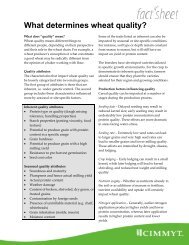

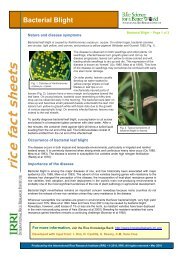

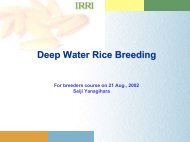
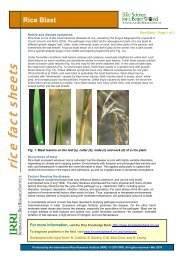
![International Standards' Organization â Rice Specification [ISO 7301]](https://img.yumpu.com/36696862/1/190x245/international-standards-organization-a-rice-specification-iso-7301.jpg?quality=85)

